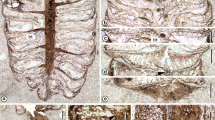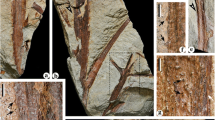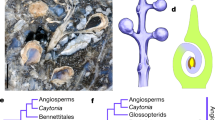Abstract
Morphological features and the affinities of petrified seed cones of the Taxodiaceae, Cupressaceae, and Sciadopityaceae are reevaluated. TheCunninghamia-like plants are the earliest record of the families.Parataiwania explains the divergence ofTaiwania from aCunninghamia-like ancestral form by loss of ovuliferous scale and sclerenchyma.Sequoia-like allies probably diverged from a Cretaceous transitional plant likeYezosequoia and are most diversified in the Late Cretaceous.Yubaristrobus andArchicupressus suggest monophyly ofTaxodium and its allied genera of the Taxodiaceae and the Cupressaceae. The Cupressaceae may be derived from a taxodiaceous plant with orthotropous seeds, acquiring a reniform arrangement of the vascular bundles of the bract-scale complex, decussate or whorled phyllotaxis, and spherical cones consisting of a small number of bract-scale complexes. The Cretaceous fossils of the Sciadopityaceae suggest the ancient origin of the family.
Similar content being viewed by others
References
Aase, H.C. 1915. Vascular anatomy of the megasporophylls of conifers. Bot. Gaz.60: 277–313.
Chase, M.W., Soltis, D.E., Olmstead, R.G., Margam, D., Les, D.H., Mishler, B.D., Duvall, M.R., Price, R.A., Hill, H.G., Qiu, Y., Kron, K.A., Rettig, J.H., Conti, E., Palmer, J.H., Manhart, J.R., Sysma, K.J., Michaels, H.J., Kress, W.J., Karol, K.G., Clark, W.D., Hedren, M., Gaut, B.S., Jansen, R.K., Kim, K., Wimpee, C.F., Smith, J.F., Furnier, G.R., Strauss, S.H., Xiang, Q., Plunkett, G.N., Soltis, P.S., Swensen, S.M., Williams, S.E., Gadek, P.A., Quinn, C.J., Eguiarte, L.E., Golenberg, E., Learn, G.H., Graham, S.W., Barrett, S.C.H., Dayanandan, S. andAlbert, V.A. 1993. Phylogenetics of seed plants: an analysis of nucleotide sequences from the plastid generbcl. Ann. Missouri Bot. Gard.80: 528–580.
Eckenwalder, J.E. 1976. Re-evaluation of Cupressaceae and Taxodiaceae: A proposed merger. Madroo23: 237–300.
Florin, R. 1951. Evolution of cordaites and conifers. Acta Horti Belgiani17: 259–388.
Florin, R. 1963. The distribution of conifer and taxad genera in time and space. Acta Horti Belgiani20: 121–312.
Gardner, J.S. 1883–1886. A Monograph of the British Eocene Flora. Palaeontol. Soc., London.
Harris, T.M. 1943. The fossil coniferElatides williamsoni. Ann. Bot., N.S.7: 325–339.
Harris, T.M. 1953. Conifers of the Taxodiaceae from the Wealden Formation of Belgium. Mem. Inst. Roy. Sci. Nat. Belg.126: 1–43.
Hart, J.A. 1987. A cladistic analysis of conifers: preliminary reports. J. Arnold Arb.68: 269–307.
Hart, J.A. andPrice, R.A. 1990. The genera of Cupressaceae (including Taxodiaceae) in the southeastern United States. J. Arnold Arbor.71: 275–322.
Hayata, B. 1931. The Sciadopityaceae represented bySciadopitys verticillata Sieb. et Zucc., an endemic species of Jacan. Bot. Mag. Tokyo45: 567–569.
Hollick, A. andJeffrey, E.C. 1909. Studies of Cretaceous coniferous remains from Kreischerville, New York. Men. N.Y. Bot. Gard.3: 1–76. with 29 plates.
LaPasha, C.A. andMiller, C.N. 1981. New taxodiaceous cones from the Upper Cretaceous of New Jersey. Amer. J. Bot.68: 1374–1382.
Lemoine-Sebastian, C. 1968. La vascularisation du complexe bractée-écaille chez le Taxodiacées. Trav. Lab. Forest. Toulouse7: 1–22.
Lemoine-Sebastian, C. 1969. La vascularisation du complexe bractée-écaille dans le cône femelle des Cupressacées. Botanica Rhedonica, Sér. A7: 3–27.
Lemoine-Sebastian, C. 1972. Étude comparative de la vascularisation et du complexe séminal chez les Cupressacées. Phytomorphology22: 246–260.
Miller, C.N. 1975. Petrified cones and needle-bearing twigs of a new taxodiaceous conifer from the Early Cretaceous of California. Amer. J. Bot.62: 706–713.
Miller, C.N. 1977. Mesozoic conifers. Bot. Gaz.43: 217–280.
Miller, C.N. 1988. Origin of modern conifer families.In C.B. Beck, ed., Origin and Evolution of Gymnosperms. Columbia Univ. Press, New York, pp. 448–486.
Miller, C.N. andCrabtree, D.R. 1989. A new taxodiaceous seed cone from the Oligocene of Washington. Amer. J. Bot.76: 133–142.
Nishida, M., Nishida, H. andOhsawa, T. 1991. Structure and affinities of petrified plants from the Cretaceous of Northern Japan and Saghalien VI.Yezosequoia shimanukii gen. et sp. nov. a petrified taxodiaceous cone from Hokkaido. J. Jpn. Bot.66: 280–291.
Nisida, M., Ohsawa, T. andNishida, H. 1992. Structure and affinities of petrified plants from the Cretaceous of Northern Japan and Saghalien VIII.Parataiwania nihongii gen.et sp. nov. a taxodiaceous cone from the Upper Cretaceous of Hokkaido. J. Jpn. Bot.67: 1–9.
Ogura, Y. 1930. On the structure and affinities of some Cretaceous plants from Hokkaido. J. Fac. Sci. Imp. Univ. Tokyo Sect. III (Bot.)2: 381–412.
Ogura, Y. 1932. On the structure and affinities of some Cretaceous plants from Hokkaido. 2nd contribution. J. Fac. Sci. Imp. Univ. Tokyo Sect. III (Bot.)2: 455–483.
Ohsawa, T., Nishida, H. andNishida, M. 1992. Structure and affinities of the petrified plants from the Cretaceous of Northern Japan and Saghalien, XI. A cupressoid seed cone from the Upper Cretaceous of Hokkaido. Bot. Mag. Tokyo105: 125–133.
Ohsawa, T., Nishida, H. andNishida, M. 1993. Structure and affinities of the petrified plants from the Cretaceous of Northern Japan and Saghalien. XIII.Yubaristrobus gen. nov., A new taxodiaceous cone from the Upper Cretaceous of Hokkaido. J. Plant Res.106: 1–9.
Ohsawa, T., Nishida, M. andNishida, H. 1991. Structure and affinities of petrified plants from the Cretaceous of Northern Japan and Saghalien IX. Petrified cone ofSciadopitys from the Upper Cretaceous of Hokkaido. J. Phytogeogr. Taxon.39: 97–105.
Ohsawa, T., Nishida, M. andNishida, H. 1992. Structure and affinities of the petrified plants from the Cretaceous of Northern Japan and Saghalien, X. TwoSequoia-like cones from the Upper Cretaceous of Hokkaido. Jap. J. Bot.67: 72–82.
Page, C.N. 1990a. Cupressaceae.In K.U. Kramer and P.S. Green, ed., Pteridophytes and Gymnosperms. Springer-Verlag, Berlin, pp. 302–316.
Page, C.N. 1990b. Sciadopityaceae.In K.U. Kramer and P.S. Green, ed., Pteridophytes and Gymnosperms. Springer-Verlag, Berlin, pp. 346–348.
Page, C.N. 1990c. Taxodiaceae.In K.U. Kramer and P.S. Green, ed., Pteridophytes and Gymnosperms. Springer-Verlag, Berlin, pp. 302–316.
Peters, M.D. andChristophel, D.C. 1978.Austrosequoia wintonensis, a new taxodiaceous cone from Queensland, Australia. Can. J. Bot.56: 3119–3128.
Pilger, R. 1926a. Cupressaceae.In A. Engler and K. Prantl, eds., Die Naturlichen Pflanzenfamilien. 2nd edition. Wilhelm Engelmann, Leipzig, pp. 361–403.
Pilger, R. 1926b. Taxodiaceae.In A. Engler and K. Prantl, eds., Die Naturlichen Pflanzenfamillen. 2nd edition. Wilhelm Engelmann, Leipzig, pp. 342–360.
Price, R.A. andLowenstein, J.M. 1989. An immunological comparison of the Sciadopityaceae, Taxodiaceae, and Cupressaceae. Syst. Bot.14: 141–149.
Radais, M. 1894. Contribution l'étude de l'anatomie comparée du fruit des coniféres. Ann. Sci. Nat. Bot. Sér. 7.19: 165–368.
Saiki, K. 1992. A new sciadopityaceous seed cone from the Upper Cretaceous of Hokkaido, Japan. Amer. J. Bot.79: 989–995.
Saiki, K. andKimura, T. 1993. Permineralized taxodiaceous seed cone from the Upper Cretaceous of Hokkaido, Japan. Rev. Palaeobot. Palynol.76: 83–96.
Satake, Y. 1934. On the systematic importance of the Japanese Taxodiaceae. Bot. Mag. Tokyo48: 186–205.
Schlabaum, S.E. andTsuchiya, T. 1985. Karyological derivation ofSciadopitys verticillata Sieb. et Zucc. from a pro-taxodiaceous ancestor. Bot. Gaz.146: 264–267.
Stewart, W.N. andRothwell, G.W. 1993. Palaeobotany and Evolution of Plants. Cambridge Univ. Press, Cambridge.
Stockey, R.A. 1981. Some comments on the origin and evolution of conifers. Can. J. Bot.59: 1932–1940.
Stopes, M.C. andFujii, K. 1910. Studies on the structure and affinities of Cretaceous plants. Philos. Trans. Roy. Soc. London Ser. B210: 1–90.
Takaso, T. andTomlinson, P.B. 1991. Cone and ovule development inSciadopitvs (Taxodiaceae-Coniferales). Amer. J. Bot.78: 417–428.
Taylor, T.N. andTaylor, E.L. 1993. The Biology and Evolution of Fossil Plants. Prentice Hall, Englewood Cliffs.
Author information
Authors and Affiliations
Rights and permissions
About this article
Cite this article
Ohsawa, T. Anatomy and relationships of petrified seed cones of the Cupressaceae, Taxodiaceae, and Sciadopityaceae. J. Plant Res. 107, 503–512 (1994). https://doi.org/10.1007/BF02344071
Received:
Accepted:
Issue Date:
DOI: https://doi.org/10.1007/BF02344071




